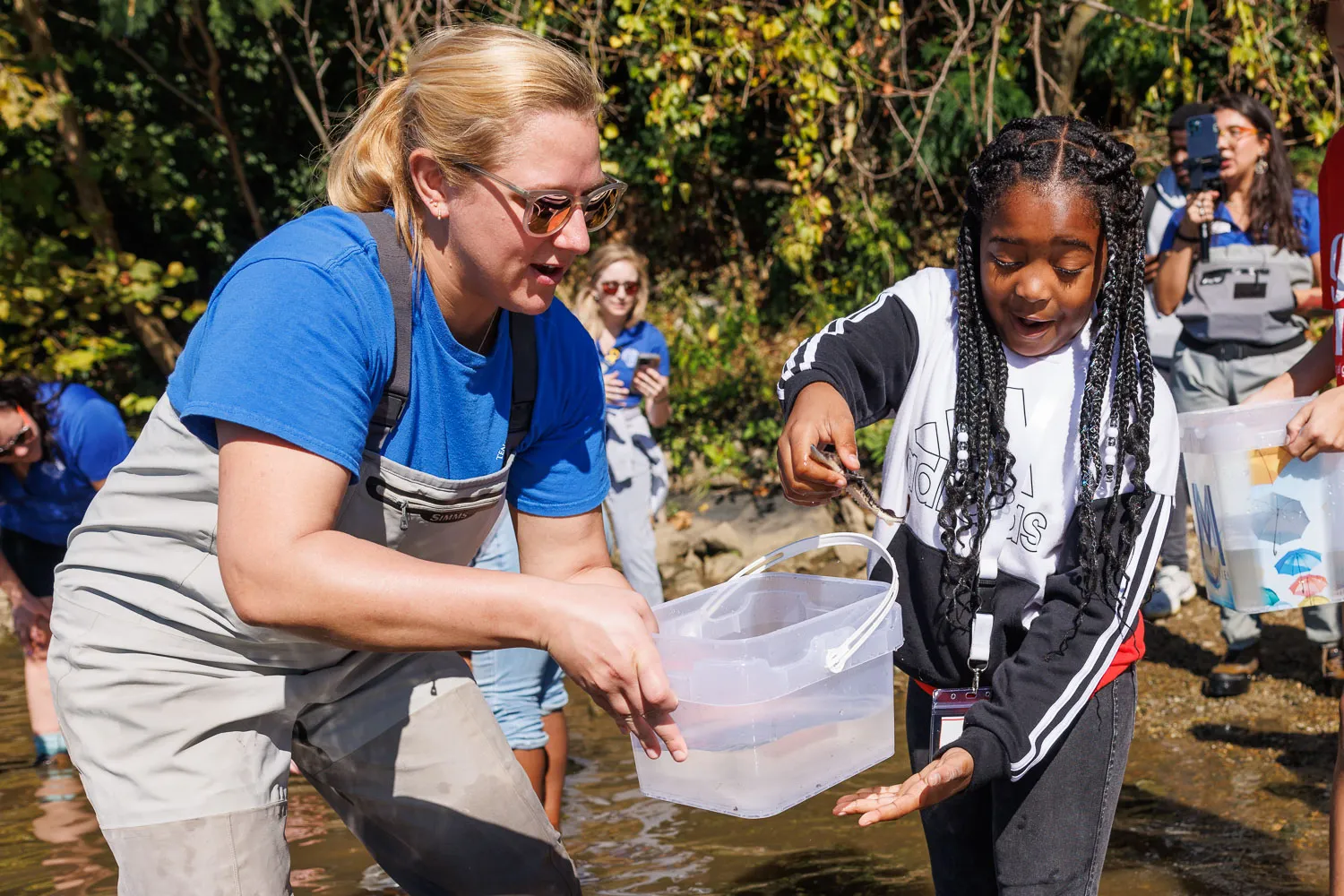Chattanooga, Tenn. (Oct. 12, 2023) – After bulking up all summer on a steady diet of bloodworms and brine shrimp, hundreds of juvenile Lake Sturgeon finally were returned to their ancestral waters this morning.
Under a nearly cloudless autumn sky, biologists from the Tennessee Aquarium Conservation Institute and third through fifth grade students from Girls Inc. of Chattanooga’s Fall Break Camp gathered on the north bank of the Tennessee River in Coolidge Park.
One by one, they carefully made their way to the river’s edge holding clear, water-filled plastic buckets containing five-month-old Lake Sturgeon. Amidst excited squeals and nervous laughter, they squatted down, gently depositing each sleek, armor-skinned fish into the shallows.
This latest release “class” included 667 Lake Sturgeon. Comparatively tiny now, these miniature river giants have the potential to reach nine feet in length and could live for up to 150 years.
Reintroduction events like this are the capstone payoff to a summer spent tirelessly caring for and — most of all — feeding these sturgeon, says Reintroduction Biologist II Teresa Israel.
“It’s really special. It’s hard to see them go, but it’s a happy day since we’ve seen them get so big, so we know they’ll be successful out there,” she says. “It’s a great accomplishment that completes the circle for all our hard work.”
Lake Sturgeon are considered endangered in Tennessee. As recently as the 1970s, this species had disappeared from both waterways due to the impacts of damming, poor water quality and over-fishing. Today’s release is the latest in the now-23-year-old effort to bring Lake Sturgeon back to the Tennessee River and Cumberland River.
In 2000, the Aquarium was among the founding members of the Lake Sturgeon Working Group. This collaborative partnership was formed with the goal of restoring Lake Sturgeon after conditions in the river improved and it could once more support a wild population.
To date, the members of the working group have raised and released more than a third of a million Lake Sturgeon into these rivers. Each juvenile was hatched from eggs collected and fertilized from adults spawning in Wisconsin’s Wolf River, which hosts a healthy wild population.
When they arrive at the Aquarium’s freshwater field station each June, the baby sturgeon are tiny, most measuring just an inch long. Biologists spend the next few months caring for them until they reach a releasable size of about six inches.
This year, improvements to the field station’s life support systems and the construction of new, larger temporary habitats have helped these sturgeon get super-sized. The class of fish released today were about eight inches long, an increase of about 33 percent over the average.
“At the Tennessee Aquarium and in the whole field of reintroduction biology, we’re always looking to make sure we adapt and modify anything we need to in order to continue getting better at whatever we’re doing,” says Dr. Anna George, the Aquarium’s vice president and chief conservation and education officer.
Each year, freshwater scientists continue to wait patiently for signs that Lake Sturgeon released into Southeastern rivers have begun reproducing. Female Lake Sturgeon do not reach sexual maturity until they are 20 years old, meaning the sturgeon released at the start of the reintroduction effort are only just now at the age when they could produce offspring of their own.
With conservation science programs as marathon as the restoration of an imperiled species, achieving success can sometimes require passing the torch to a new generations of biologists. Given that time scale, it’s even more important that the public understands and feels involved in event’s like today’s release, Dr. George.
“For a conservation program like our work with the Lake Sturgeon, we could just put them back in the river, but it’s really important to us at the Aquarium that we use moments like these to involve the community and engage them in the work we do,” she says. “These students from Girls Inc. were so excited to release sturgeon with us back into the Tennessee River. Some of them were jumping back in line again and again to release four or five sturgeon, which was really wonderful to see.”
To learn more about Lake Sturgeon and the Aquarium’s efforts to restore this species, visit tnaqua.org/animal/lake-sturgeon/
Want to see a live video stream of the Aquarium’s newly opened Sturgeon Bend touch experience? Go to tnaqua.org/live/lake-sturgeon-cam/
